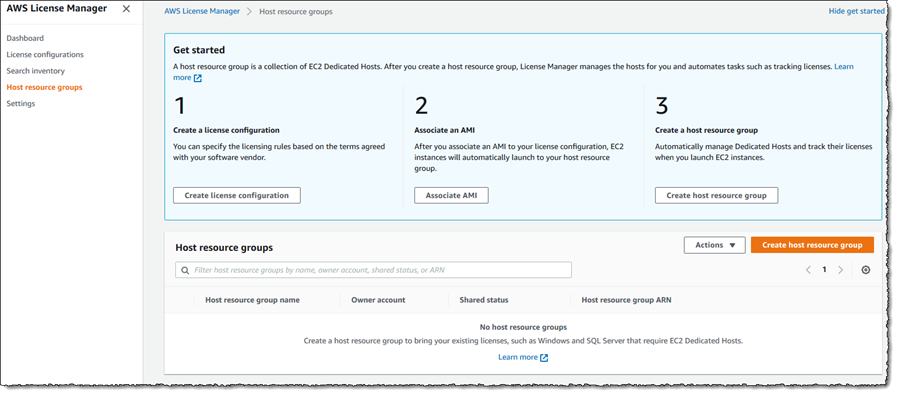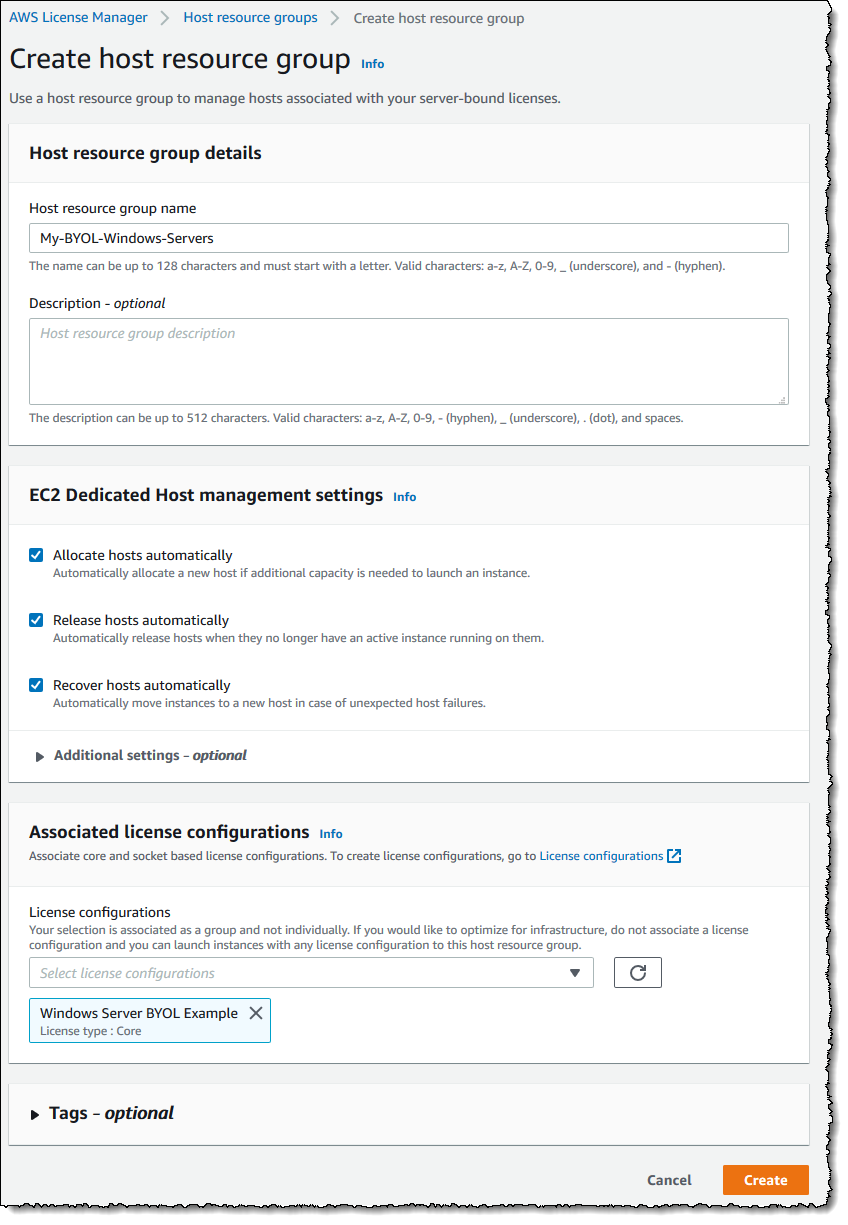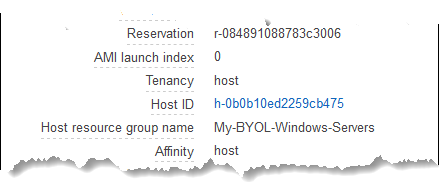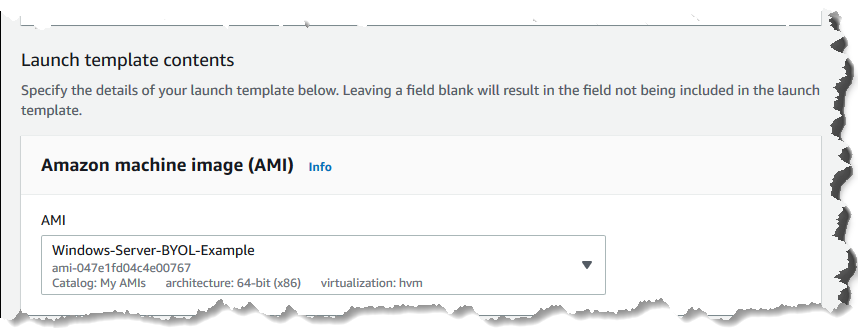Customers have asked us to provide an easier way to bring, and manage, their existing licenses for Microsoft Windows Server and SQL Server to AWS. Today we are excited to announce a new, simpler, bring-your-own-license (BYOL) experience.
When launching Windows Server or SQL Server instances, customers can use licenses from AWS with a pay-as-you-go model or they can bring their own existing licenses. When using software licenses obtained from AWS, customers get a fully-compliant, pay-as-you-go licensing model that doesn’t require managing complex licensing terms and conditions. The new BYOL experience launched today enables those customers who want to use their existing Windows Server or SQL Server licenses to seamlessly create virtual machines in EC2, while AWS takes care of managing their licenses to help ensure compliance to licensing rules specified by the customer.
Previously, when bringing their own server-bound licenses, customers needed to write additional automation to manage capacity, and ensure effective utilization of the dedicated hosts that are required for BYOL. This process made managing hosts non-EC2 like, and certainly unlike the simple and easy-to-use experience when using licenses provided by AWS. The new BYOL experience simplifies the host management experience for customers, by automating the key host management tasks such as allocation and release of hosts, managing host capacity, and enabling capabilities such as auto scaling and auto recovery of hosts. As a result, you can simply create a BYOL instance on Dedicated Host the way you create any other EC2 instance.
Let’s take a walk-through of the new, simplified, experience to bring a licensed image to the AWS Cloud. In this post I am going to use a Windows Server license but the experience is the same if I wanted to bring Windows Server and SQL Server licenses.
Setting up License Management
With my licensed image imported and available as a private AMI in my account in Amazon Elastic Compute Cloud (EC2), it’s time to head to the AWS License Manager console and get started by first creating a license configuration, which I do by clicking Create license configuration from the License Configurations page. I fill out a name for the configuration, an optional description, and select the License type, which in this case I set to Cores. Note that I can set an upper limit for cores, which we recommend customers set according to the number of licenses they are bringing, in addition to enabling Enforce license limit. For this walk-through I’m going to leave both unset. Clicking Submit creates the new license configuration, which will then be shown on the License configurations page.
The next step is to associate the AMI containing my licensed operating system image with the configuration. Selecting the configuration I just created, from Actions I select Associate AMI. This takes me to a page listing my custom images, where I select the image I want and click Associate (note that I could select and associate multiple images, for example I could also add my Windows Server and SQL Server image also shown below).
With my license configuration setup completed for my Windows Server – don’t forget, I could also have set up a configuration to bring my Windows Server with SQL Server licenses too – I next need to create a Host resource group and associate it with the license configuration. A Host resource group is a collection of Dedicated Hosts that can be managed together as a single entity using your specified preferences. I start by selecting Host resource groups from the navigation panel, and then clicking Create host resource group.
I give my Host resource group a name, and select the license configurations I want to associate with this group (I can select more than one), then click Create. Note the options for EC2 Dedicated Host management. Leaving these selected means I do not need to manage capacity and Dedicated Hosts myself. AWS License Manager will automatically manage my hosts for me when I launch instances into a Host resource group, and also ensure I stay within my license count limits if so configured.
That’s it for setting up my license configuration and Host resource group, so now I can head to the Amazon EC2 console and launch some instances. Before I do, I want to bring to your attention one more feature of the new BYOL experience – integration with AWS Organizations. If my account is the master account for an Organization, an additional option is shown when creating Host resource groups – Share host resource group with all my member accounts. As the name suggests, selecting this option will cause the Host resource group to be shared with the member accounts in my Organization. When member accounts launch instances, the hosts get allocated automatically in my master account. This enables me to use the same host across multiple accounts, and not require hosts in every member account, increasing host utilization.
Launching an Automatically Managed BYOL Image
In the Amazon EC2 console I click Launch instance and select the AMI that contains my licensed version of Windows Server (or Windows Server with SQL Server, if that is what I am bringing), on the My AMIs tab in the launch wizard, then select the instance type I want to launch, before arriving at the Configure Instance Details page.
In the launch wizard, as I have selected an image associated with a license configuration, Tenancy is already preset to the required Dedicated host – Launch this instance on a Dedicated host setting. I toggle the option under Host resource group to Launch instance into a host resource group and can then select the appropriate Host resource group. In the screenshot below I’ve selected my group, however, if I have only one group, EC2 will automatically launch the instance in the mapped Host resource group based on the license configuration attached, without me needing to select it in the launch wizard.
In order to maximize utilization, the new experience also provides for heterogeneous instance support on Dedicated Hosts. What that means is if I launch different sized instances of the same family, an attempt is made to place them together on the same host (previously you could only create instances of the same size and family on one host).
At this point, I can click Review and launch, although you likely have more settings you want to specify for storage, tags, and security group, before proceeding. Once the instance(s) have launched, on selecting an instance in the console the Details tab shows me it has been associated with a Host resource group. I can optionally also click the Host ID to view details of the host.
BYOL, Auto Scaling and Dedicated Hosts
Automatic management of instances launched through Auto Scaling onto Dedicated Hosts is an additional benefit of the new BYOL support, and is easy to set up and use. In the launch wizard shown above, I could have created and specified a new Auto Scaling group, but instead I’ve chosen to create a Launch Template and used that to define settings for my Auto Scaling group. In the snapshots below, you can see that all I need do in the launch template is select my licensed image and then, under Advanced Details, my license configuration.
Next I simply specify the template when creating an Auto Scaling group, and I’m done! As new instances are created in the group during launch, or a scaling event, they will be mapped automatically onto a Dedicated Host, something that has not been possible when using BYOL before today.
Availability of the New BYOL Experience
The new BYOL experience is available for your eligible Windows Server and SQL Server licenses. As a reminder, customers can also bring their own SQL Server licenses with Active Software Assurance to default (shared) tenant EC2 through License Mobility benefits. This new experience gives our SQL Server customers another way to bring their existing licenses. For more information on licensing, please visit the Windows on AWS FAQ. Additional information on Microsoft licensing options on AWS can be found here. Be sure to also check out AWS License Manager, to learn more about management preferences.
The simpler BYOL experience is available now to customers in the US-East (Northern Virginia) and US-West (Oregon) regions, and will be available in other regions in the coming days.
— SteveAmazon
via https://www.aiupnow.com
Steve Roberts, Khareem Sudlow









